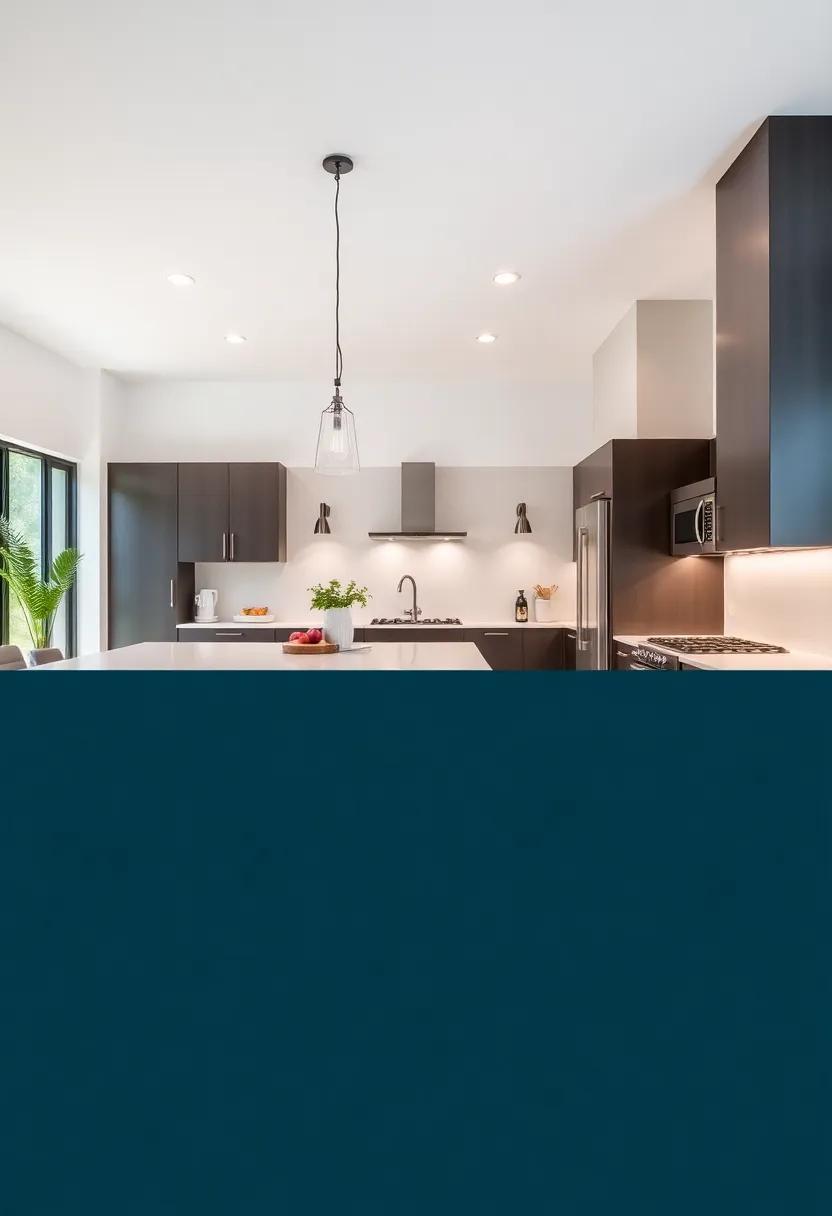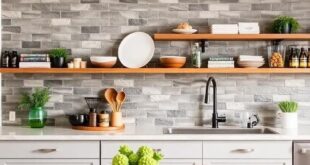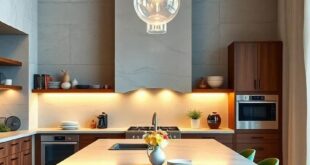In today’s era of modern living, the kitchen has evolved far beyond just a space for cooking. It serves as the heart of the home, a gathering place for family and friends, and a canvas for culinary creativity. As the trend towards open concept design continues to gain momentum, homeowners are increasingly seeking to break down customary barriers and create inviting, multifunctional spaces. “” aims to inspire and inform you on this exciting journey. Whether you’re envisioning a seamless flow between yoru kitchen and living areas or looking to maximize the functionality of your home, this guide will provide you with practical tips, design insights, and creative ideas to help you reimagine your kitchen. Dive in and discover how an open concept remodel can not only enhance your space but also elevate your lifestyle.
Transforming Your space with Open Concept Layouts That Inspire
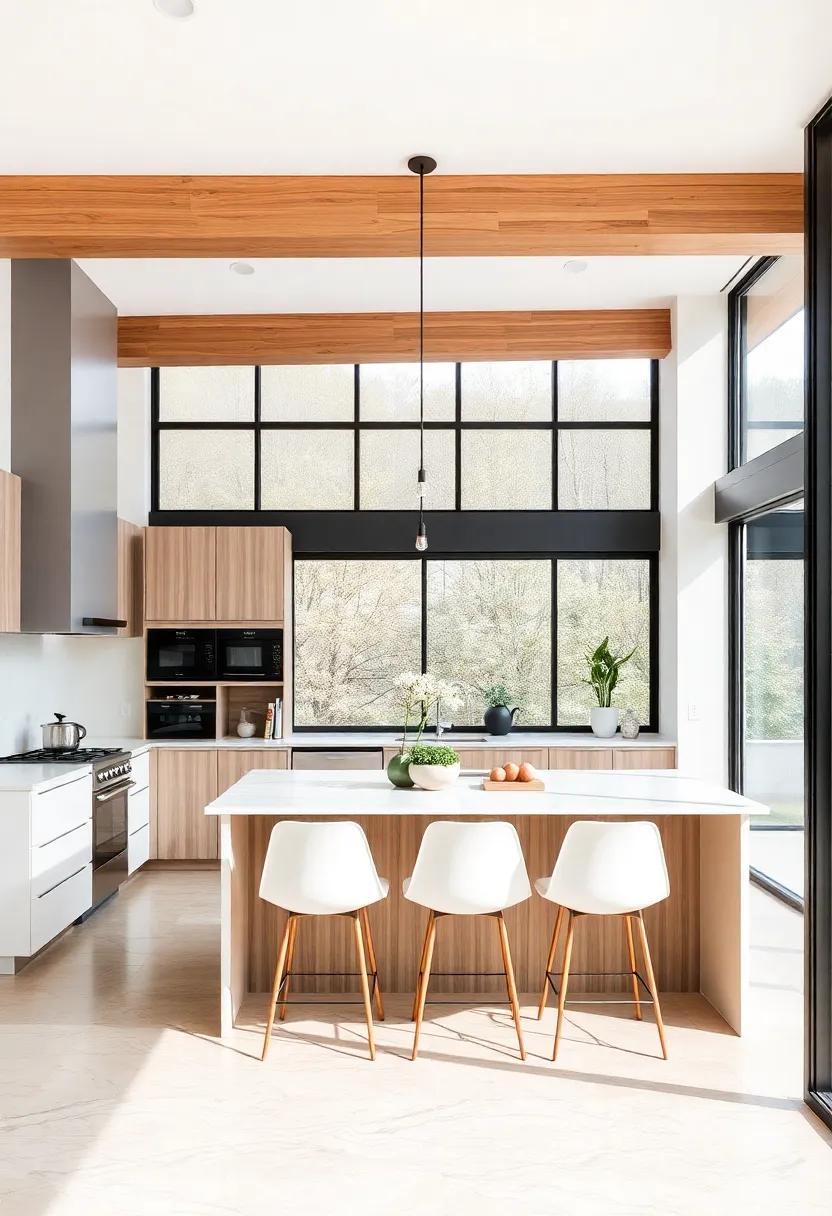
Embracing an open concept layout can truly redefine your living space, creating an habitat that fosters connection and creativity. Imagine gathering in a spacious area where the kitchen, dining, and living areas flow seamlessly into one another, invigorating the atmosphere of your home. By removing barriers and unneeded walls, you not only enhance visual continuity but also maximize natural light, making even the coziest corners feel expansive and inviting. The sense of freedom and flow allows for more engaging interactions, whether you’re cooking a family meal or entertaining guests.
To achieve a captivating open concept design, consider incorporating elements that enhance both functionality and aesthetics. key strategies for transformation include:
- Utilizing large kitchen islands as functional workspaces and social hubs.
- Incorporating cohesive color palettes and materials to unify different areas.
- Choosing stylish furniture arrangements that encourage conversations and connections.
- Integrating multifunctional storage solutions to maintain an organized, clutter-free environment.
HereS a brief overview to inspire your design choices:
| design Element | Purpose |
|---|---|
| Kitchen Island | Gathering & prep space |
| Open Shelving | Display & easy access |
| Large Windows | natural light & ventilation |
| Subtle Dividers | Define areas without isolation |
The Art of Merging Kitchen and Living Areas for Seamless Flow
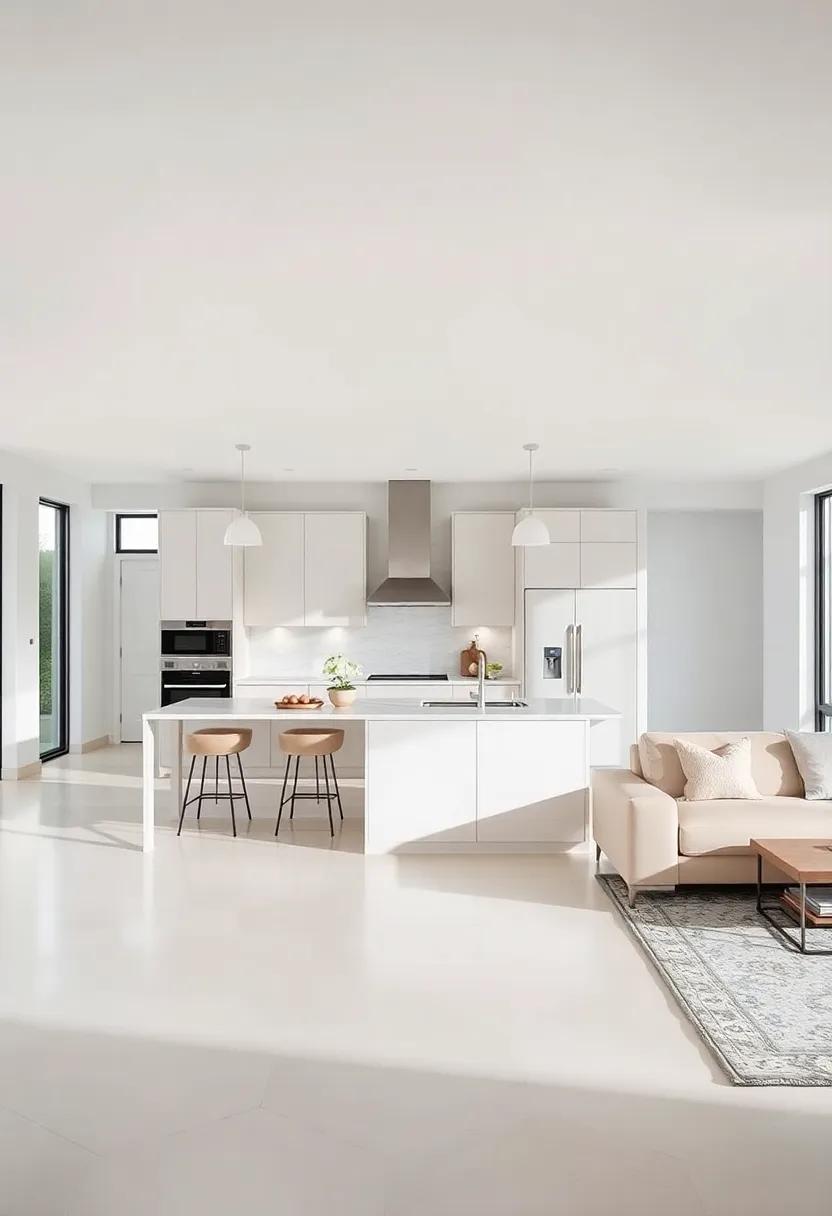
Creating a harmonious blend between kitchen and living areas involves a thoughtful approach to both design and functionality. To achieve an inviting and cohesive space, consider focusing on elements such as color palettes, lighting, and furniture placement.A unified color scheme helps in creating a sense of continuity. Opt for warm neutrals or a consistent hue throughout both areas to visually connect them. Incorporating open shelving or cabinets that reveal the beauty of kitchenware can also enhance the aesthetic appeal,turning everyday items into decor. Moreover, adequate lighting plays a crucial role; using layered lights—such as pendant lamps over an island, along with floor lamps in the living space—can set the mood and provide practical illumination.
Furniture arrangement is another key aspect of this design. L-shape or U-shape layouts encourage conversation and interaction, drawing guests into the space seamlessly. Use multi-functional furniture, like an island with seating that doubles as a dining area, to maximize utility without crowding the room. Establishing clear pathways ensures that movement between the two areas flows naturally. To inspire your design choices, consider a style table that balances aesthetics with practicality:
| Design Element | Purpose |
|---|---|
| Color Palette | Creates visual continuity |
| Lighting | Enhances ambiance and functionality |
| Furniture Layout | Encourages interaction and comfort |
| Multi-functional Pieces | Maximizes space efficiency |
Creating a Functional Kitchen Island as a Focal Point in Design
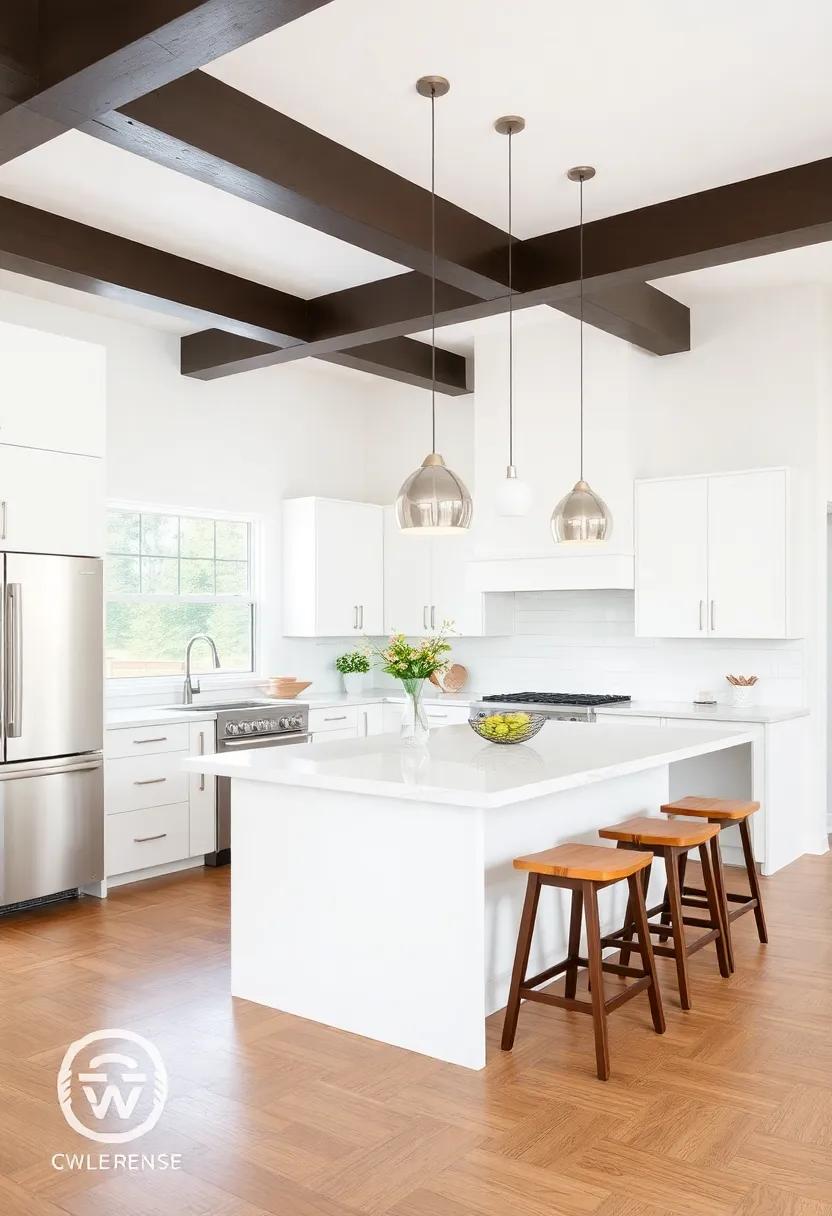
Designing a kitchen island that serves as a stunning focal point involves a mix of functionality, aesthetics, and practicality. The ideal island not only enhances the visual appeal of your open concept space but also increases the efficiency of your kitchen.Consider incorporating elements such as high-quality materials, ample storage, and seating options. Choosing materials like granite or quartz countertops can add sophistication, while a wooden base brings warmth and texture to the room. Evaluate your available space to determine whether your island should have a cooktop, under-counter appliances, or simply act as an expansive prep area.
To maximize the functionality, think about the layout and how traffic flows around the island. Visual interest can be achieved through a dual-height design or contrasting colors for the cabinetry and countertops. Here are some ideas to consider:
- lighting: Include pendant lights above the island to create ambiance and illuminate work areas.
- Multi-purpose features: Incorporate shelves for cookbooks,open storage for decorative plates,or even a wine rack.
- Seating Arrangement: Ensure cozy seating options that encourage family gatherings or casual dining.
Maximizing Natural Light in Your Open Concept Kitchen Remodel
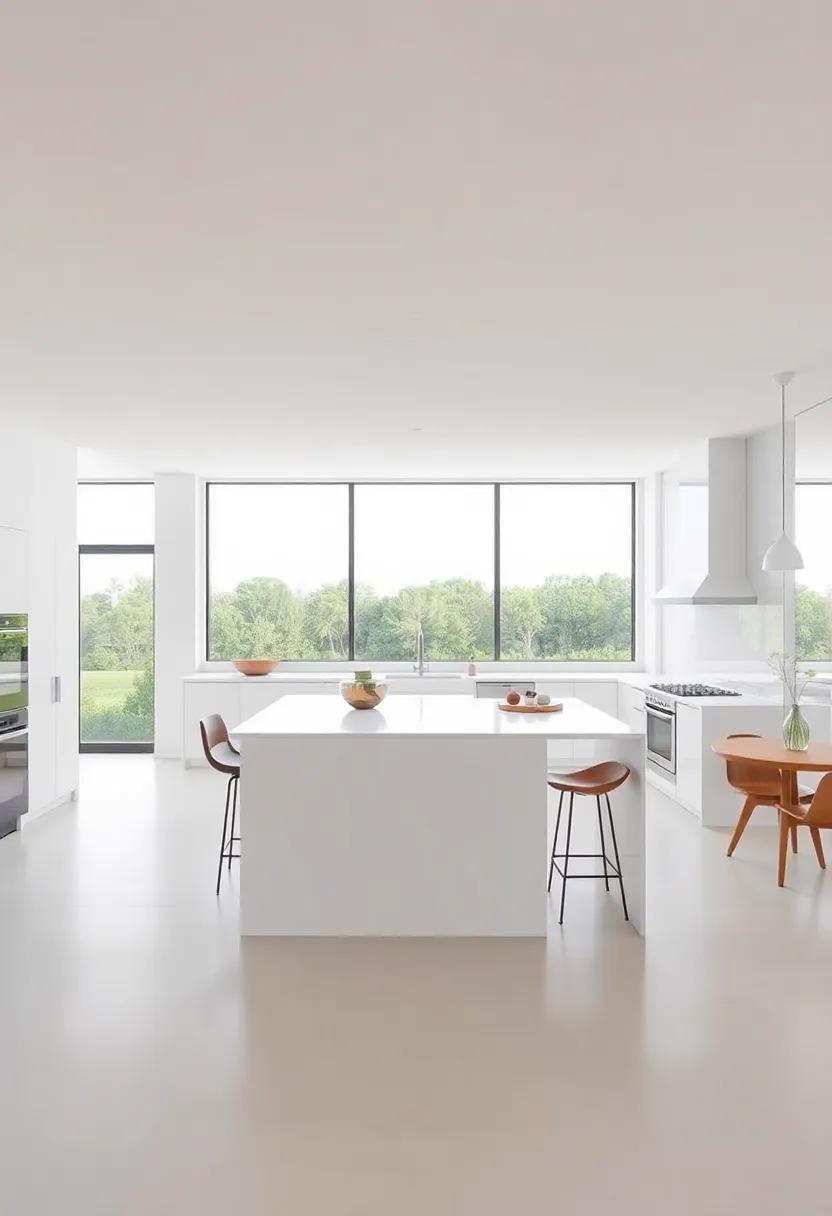
To fully embrace the beauty of an open concept kitchen, integrating natural light is essential.skylights are a fantastic option, allowing sunlight to pour in from above, creating an airy atmosphere. If you’re not ready for a big renovation, consider adding larger windows or replacing existing ones with glazed glass to enhance light diffusion. Additionally, the choice of materials plays a crucial role; opt for light-colored cabinetry and finishes that reflect light rather then absorb it, cultivating a bright and welcoming space.
Strategically placing mirrors can dramatically amplify natural light in your kitchen layout. Position a large mirror opposite a window to bounce sunlight throughout the room, creating an illusion of openness. Don’t forget your window treatments; selecting sheer curtains will allow light to filter in while maintaining privacy.You may even explore the trend of open shelving, which not only showcases beautiful dishware but also permits light to travel freely around your kitchen. The incorporation of these elements works harmoniously to transform your kitchen into a luminous haven.
Choosing the Right Color Palette for a Harmonious Space Transformation
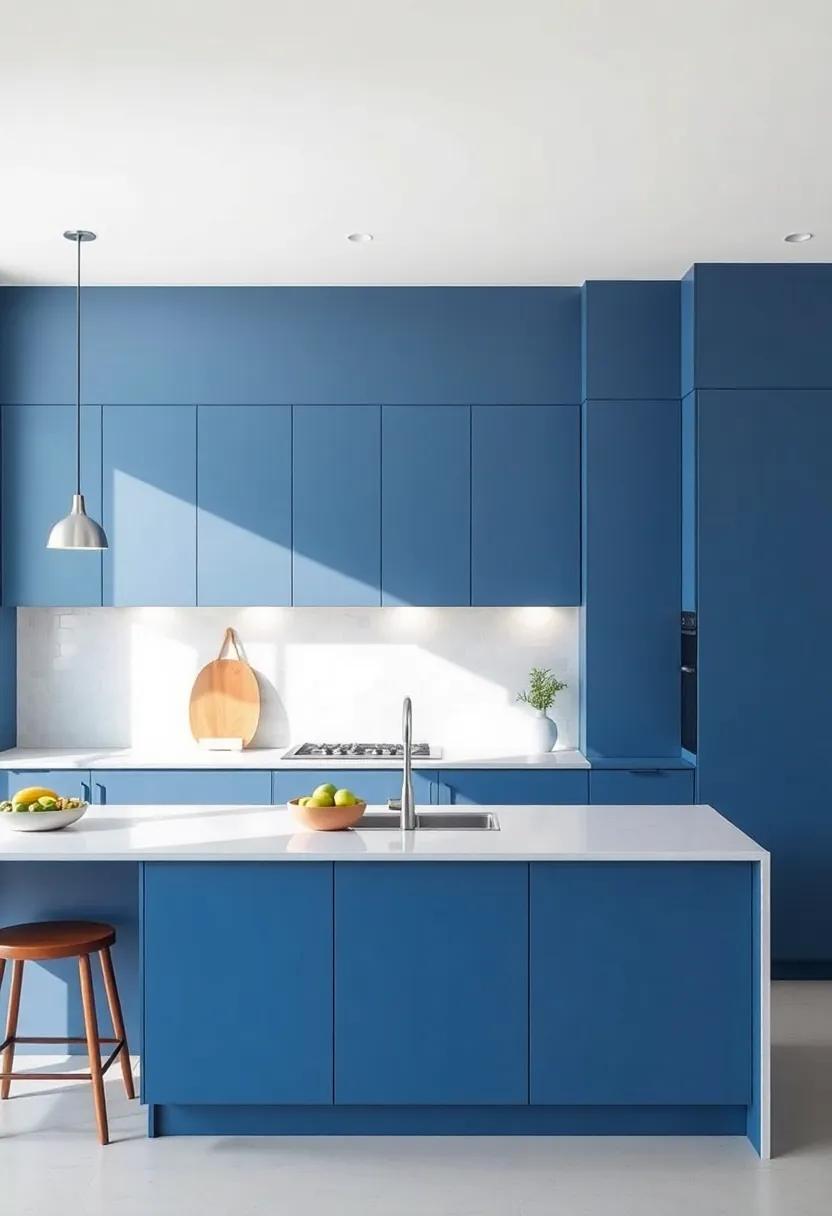
Color is a powerful tool in interior design, especially when it comes to creating a cohesive and inviting atmosphere in an open concept kitchen. To choose a color palette that promotes harmony, consider the overall mood you wish to achieve. Here are some color strategies to ponder:
- Monochromatic Schemes: Utilize variations of a single color for a sophisticated look.
- Analogous Colors: Select colors that sit next to each other on the color wheel, as they complement one another easily.
- Contrasting Accents: Pair neutrals with bold colors to create focal points without overwhelming the space.
When finalizing your color choices, think about the materials and textures you will be incorporating, as these can considerably influence how colors interact with one another. Consider creating a mood board that combines different paint samples, fabric swatches, and flooring options. The following table illustrates some color combinations that work particularly well in open concept kitchens:
| Base Color | Complementary Accent | Suggested Material |
|---|---|---|
| Soft Gray | Rich Teal | Matte Finish Cabinetry |
| Warm Beige | Burnt Orange | Textured Backsplash |
| Classic White | Deep Eggplant | Glossy Countertops |
Selecting Durable Materials That Balance Style and Usability
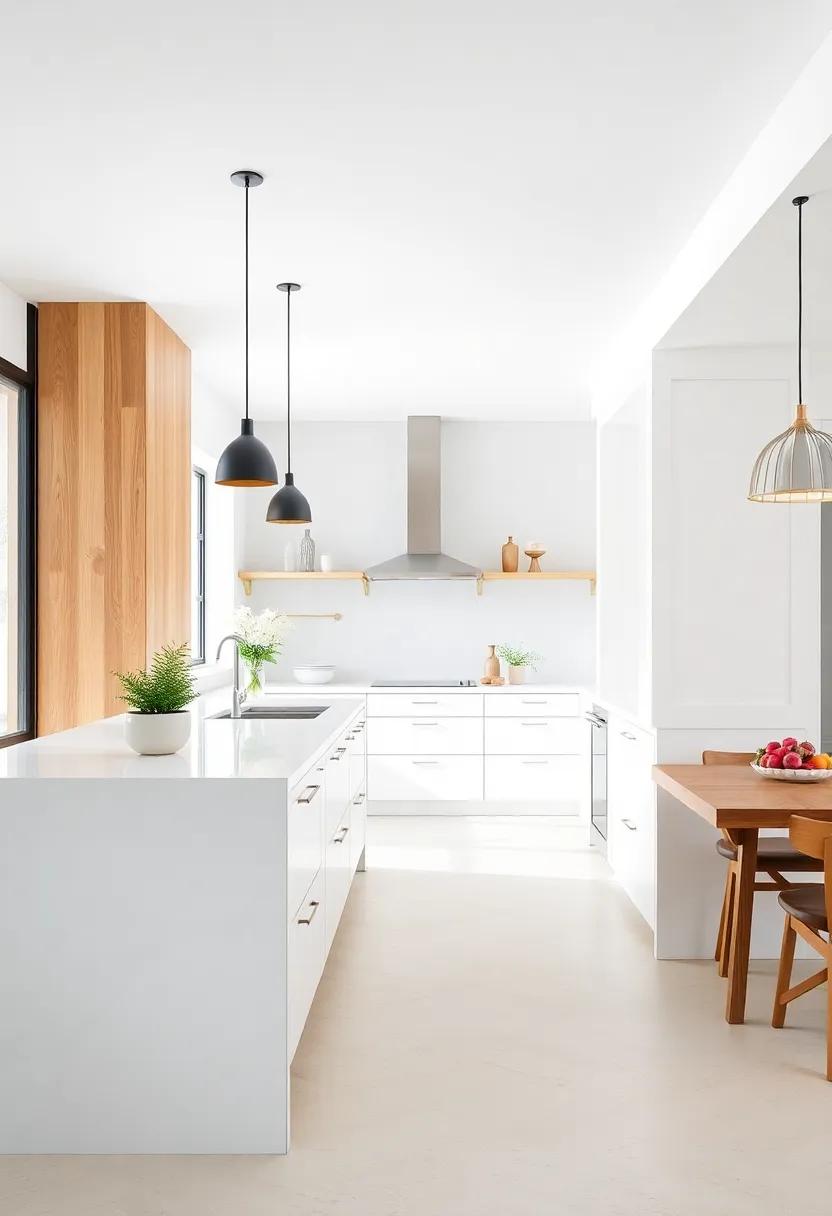
When it comes to open concept kitchen remodels, choosing materials that are both durable and aesthetically pleasing can greatly enhance the overall ambiance of your space. Natural stones such as granite or quartz not only exude elegance but also stand up to the rigors of daily use, making them ideal for countertops. Consider integrating hardwood or luxury vinyl flooring that mimics the appearance of wood; these materials are resistant to scratches and stains, ensuring longevity while maintaining a stylish look. Incorporating water-resistant finishes on cabinetry can also provide an extra layer of protection against spills and humidity.
To accentuate usability without compromising style, explore options like metal accents or open shelving made from recycled materials.These enduring choices can add character to your kitchen while allowing for easy access to everyday items.Here’s a rapid comparison of popular materials based on style and usability:
| Material | Durability | Style Factor | Cost |
|---|---|---|---|
| Granite | High | Elegant | Medium-High |
| Quartz | High | Modern | Medium-High |
| Hardwood Flooring | Medium | Classic | Medium |
| Luxury Vinyl | High | Versatile | Low-Medium |
Incorporating Smart Technology for a Modern Kitchen Experience
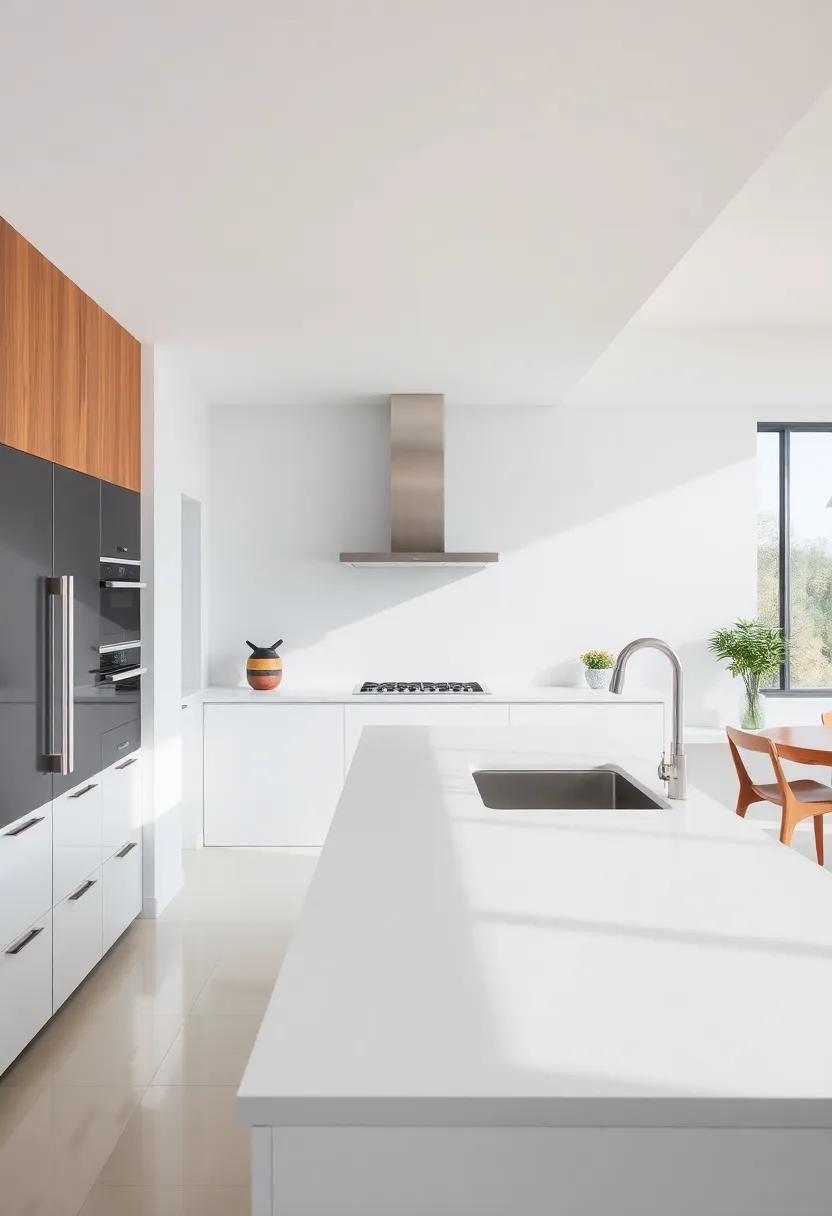
In today’s digital age, integrating smart technology into your kitchen can revolutionize how you interact with this essential space.Imagine controlling your kitchen appliances from the palm of your hand through a smartphone app. Smart ovens can now help monitor cooking times and adjust temperatures, freeing you from constantly checking on dishes. Additionally, voice-activated assistants can manage timers, provide cooking tips, and even suggest recipes based on ingredients you have at home. These technologies not only enhance convenience but also promote safety by allowing you to manage tasks without being physically present in the kitchen.
Beyond appliances, consider incorporating smart home systems that allow for seamless connectivity throughout your open-concept layout. Smart lighting systems can adjust based on the time of day, creating a warm, inviting atmosphere for family gatherings or a bright, focused environment for meal prep. Furthermore, installing smart thermostats can help maintain the perfect kitchen temperature, optimizing energy usage. To illustrate the possibilities, here’s a simple overview of popular smart technologies that can elevate your kitchen experience:
| Smart Technology | benefits |
|---|---|
| Smart Ovens | Remote control & monitoring |
| Smart Refrigerators | Inventory tracking & recipe suggestions |
| Smart Lighting | Energy-efficient & mood setting |
| Voice-Activated Assistants | Hands-free kitchen management |
Understanding the Importance of Flow in Open Concept Living
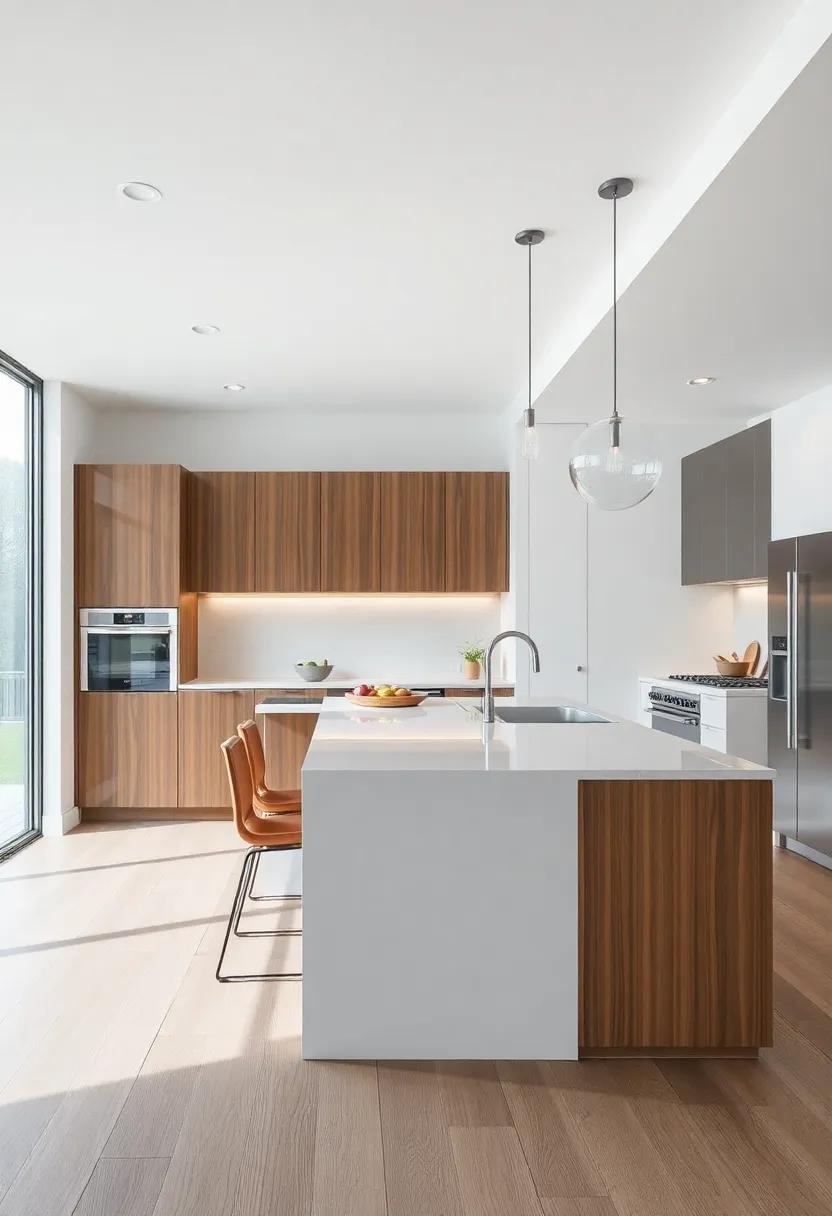
In open concept living, achieving a harmonious flow is essential for creating a welcoming and functional environment. Flow refers to the seamless transition between different areas, allowing the space to be both visually appealing and practical.A well-designed layout encourages movement and interaction, enhancing the overall experience of the home. Key elements to consider include:
- Sight Lines: Ensure unobstructed views to create a sense of openness.
- Color Schemes: Use a cohesive palette to tie different zones together.
- Lighting: Employ a mix of task, ambient, and accent lighting to define areas.
When remodeling an open concept kitchen, prioritizing flow can significantly elevate the space’s usability and charm. Thoughtful placement of furniture and fixtures can foster conversational spaces and facilitate movement. one effective strategy is to create defined zones through strategic use of area rugs, islands, or even furniture arrangement. This not only helps delineate spaces but also maintains an open yet organized feel.Consider these design options:
| Zone | Design Element | Functionality |
|---|---|---|
| Cooking area | Central Island | Prep Space & Seating |
| Dining Space | Defined Seating Area | Encourages Gathering |
| Lounge Area | cozy Seating | Relaxation & Conversation |
designing Storage Solutions That Keep Your Kitchen Organized

Creating a well-organized kitchen within an open concept space requires strategic planning and clever design. Maximizing vertical space is key; consider installing shelving units that reach the ceiling, allowing for both decorative and functional storage. Another effective option is to integrate pull-out cabinets and hidden compartments that blend seamlessly with your kitchen island or cabinetry, providing easy access while maintaining a clean aesthetic. Remember to allocate designated areas for frequently used items like pots, pans, and utensils, to reduce clutter and make cooking more efficient.
Incorporate multifunctional furniture to encourage organization without sacrificing style. Consider adding a kitchen cart or island with built-in storage options that can double as a prep station. Use decorative baskets for storing smaller items, which not only keeps things tidy but also adds a personal touch to your décor. Organizing tools like magnetic strips for knives or hanging racks for pots can also create a visually appealing display while ensuring everything has its place. To truly achieve harmony, regular decluttering and reassessing storage systems should become part of your maintenance routine.
Stunning Lighting Ideas to Enhance Your Open Concept Kitchen
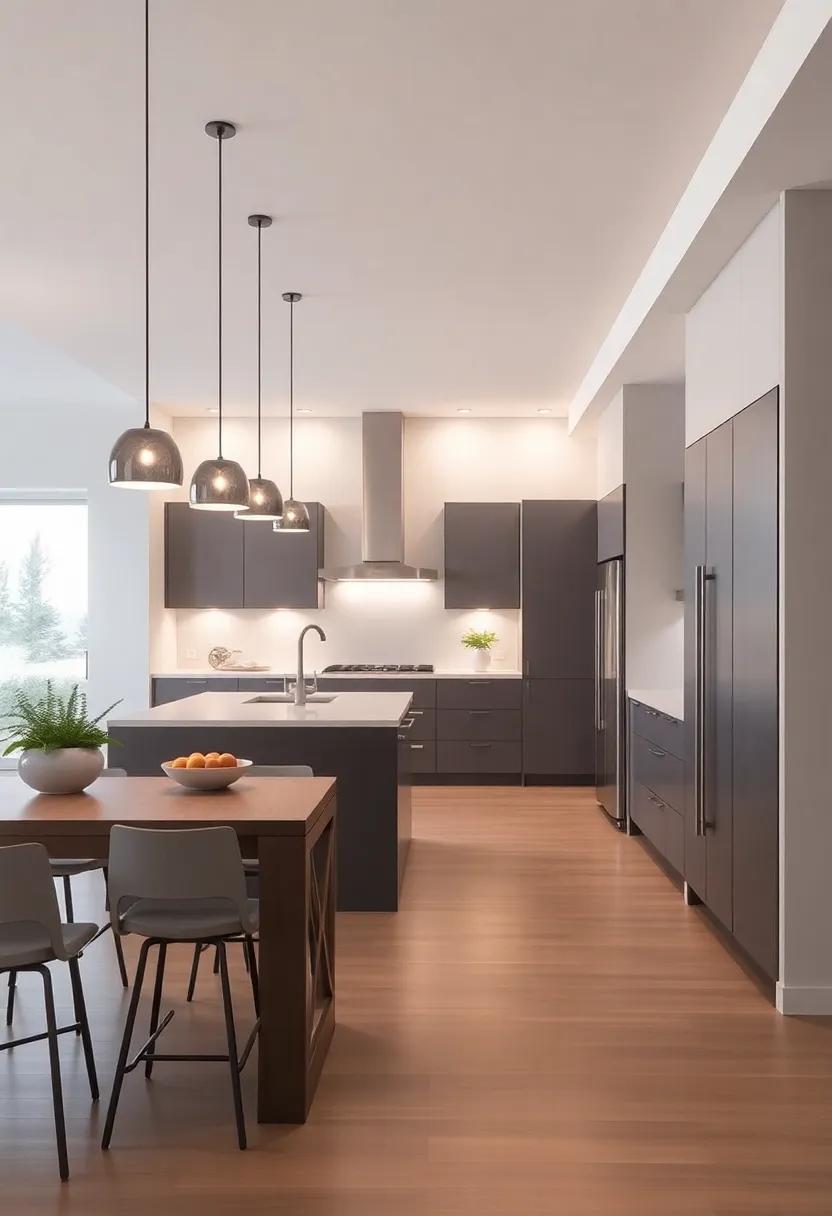
Illuminating an open concept kitchen requires a blend of functionality and aesthetics. Pendant lights are a fantastic choice to define zones within your space. Hang a trio of chic glass pendants above your kitchen island to draw attention and create a warm ambiance. For a splash of elegance, consider using drum shades or metallic finishes that can tie in with your overall kitchen decor. Furthermore, under-cabinet lighting is essential not just for task lighting, but it also adds a layer of depth by highlighting your countertops and backsplash.
To really uplift your kitchen’s feel, integrate smart lighting solutions that adapt to your needs. With the help of dimmable LED fixtures and color-changing options, you can easily transition from vibrant cooking light to a soothing dinner atmosphere. Recessed lighting strategically placed across the ceiling offers a clean, streamlined look, while retaining the open concept vibe. Incorporating a statement chandelier over the dining area can also provide both elegance and a focal point, ensuring that your open space remains inviting and stylish.
integrating Multi-functional Furniture for Effortless Entertaining
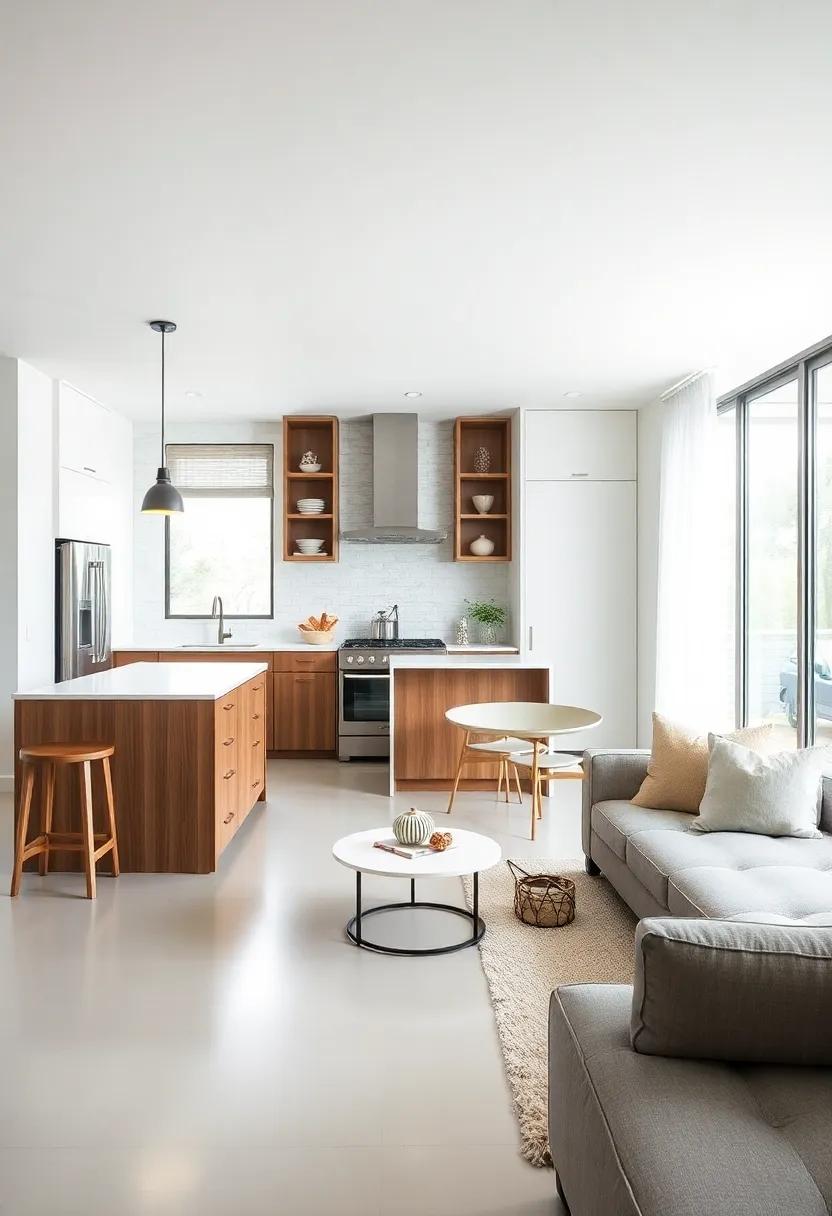
Embracing the art of entertaining within an open concept kitchen requires a thoughtful selection of multi-functional furniture.By choosing adaptable pieces,you can create seamless transitions between cooking and socializing areas,ensuring your space remains both stylish and practical. Consider incorporating:
- Island with Storage: A central island that doubles as a prep space and a gathering place keeps essentials close at hand.
- Expandable Dining tables: A table that can shift from intimate dinners to larger gatherings offers flexibility for any occasion.
- Versatile Seating: Bar stools or benches provide extra seating while enhancing the aesthetic appeal of your kitchen.
Along with individual pieces, consider a cohesive design that ties your kitchen and living space together.Use a combination of textures, colors, and materials to achieve a harmonious look. For an efficient layout, think about the workflow and how guests will interact in the space. Check out this simple comparison table highlighting essential multi-functional furniture:
| Furniture Type | Functionality | Style Tip |
|---|---|---|
| Kitchen Island | Prep + Dining | Choose a contrasting color to stand out. |
| Drop-Leaf Table | Compact + Expandable | Pair with mismatched chairs for a casual vibe. |
| Sofa Bed | Sitting + Sleeping | Select a chic design that complements your decor. |
Exploring Different Styles: From Rustic to Contemporary Designs
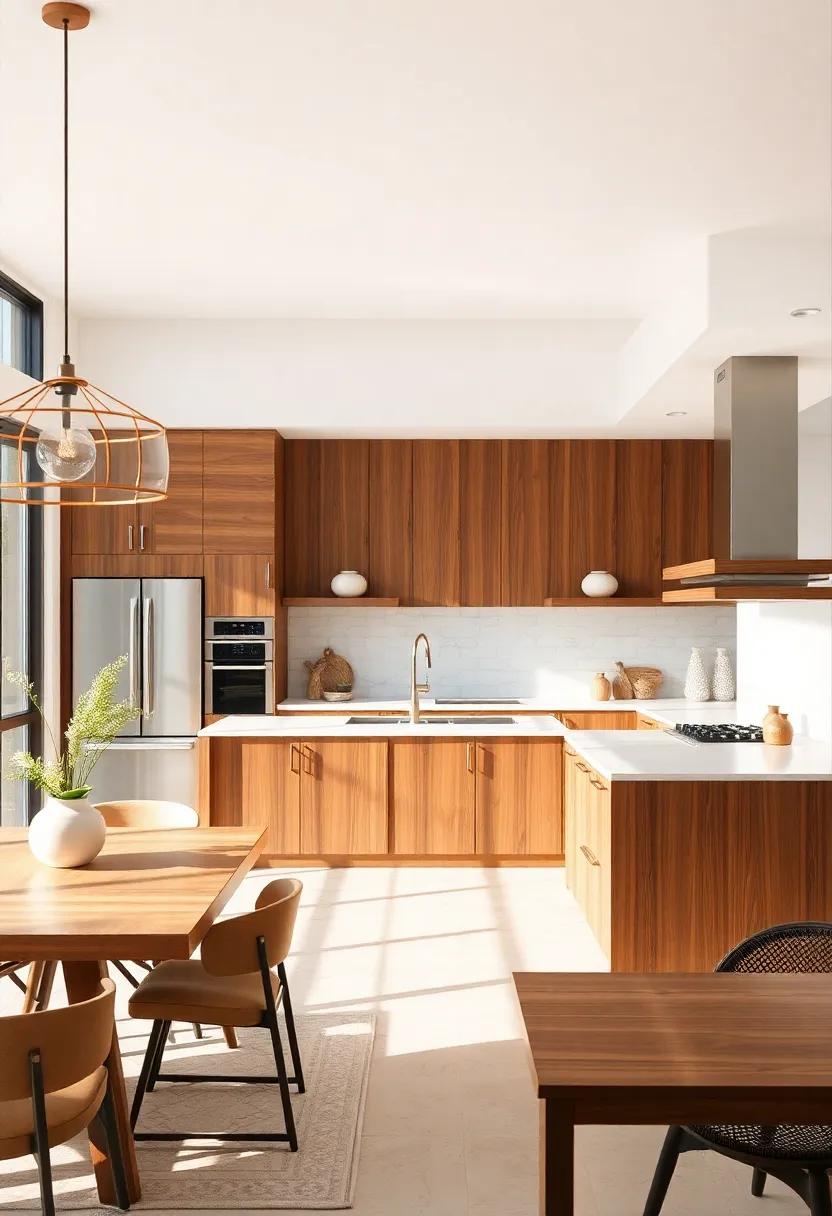
When embarking on an open concept kitchen remodel, consider how different design styles can shape your space. Embracing rustic elements, such as reclaimed wood beams and distressed cabinetry, can add warmth and character. Pair these elements with modern appliances to create a juxtaposition that feels both inviting and functional. alternatively, if a sleek and minimalist aesthetic speaks to you, opt for a contemporary design featuring clean lines, high-gloss finishes, and a muted color palette. This style frequently enough utilizes open shelving and reflective surfaces to enhance brightness and openness, making the kitchen a true centerpiece of the home.
To further refine your kitchen’s design, here are some popular styles to consider:
- Farmhouse: Combines vintage charm with modern convenience.
- Industrial: Uses metal accents and exposed pipes for an urban feel.
- Scandinavian: Emphasizes simplicity, functionality, and a light, airy atmosphere.
- Transitional: Blends traditional and contemporary features for a timeless look.
| Style | Key Features |
|---|---|
| Rustic | Natural materials, warm colors, cozy ambiance |
| Contemporary | Sleek lines, bold textures, open spaces |
| Modern | Minimalist, functional, state-of-the-art appliances |
| Traditional | Classic elements, detailed moldings, timeless designs |
A Guide to Choosing the Perfect Appliances for Open Concept Spaces
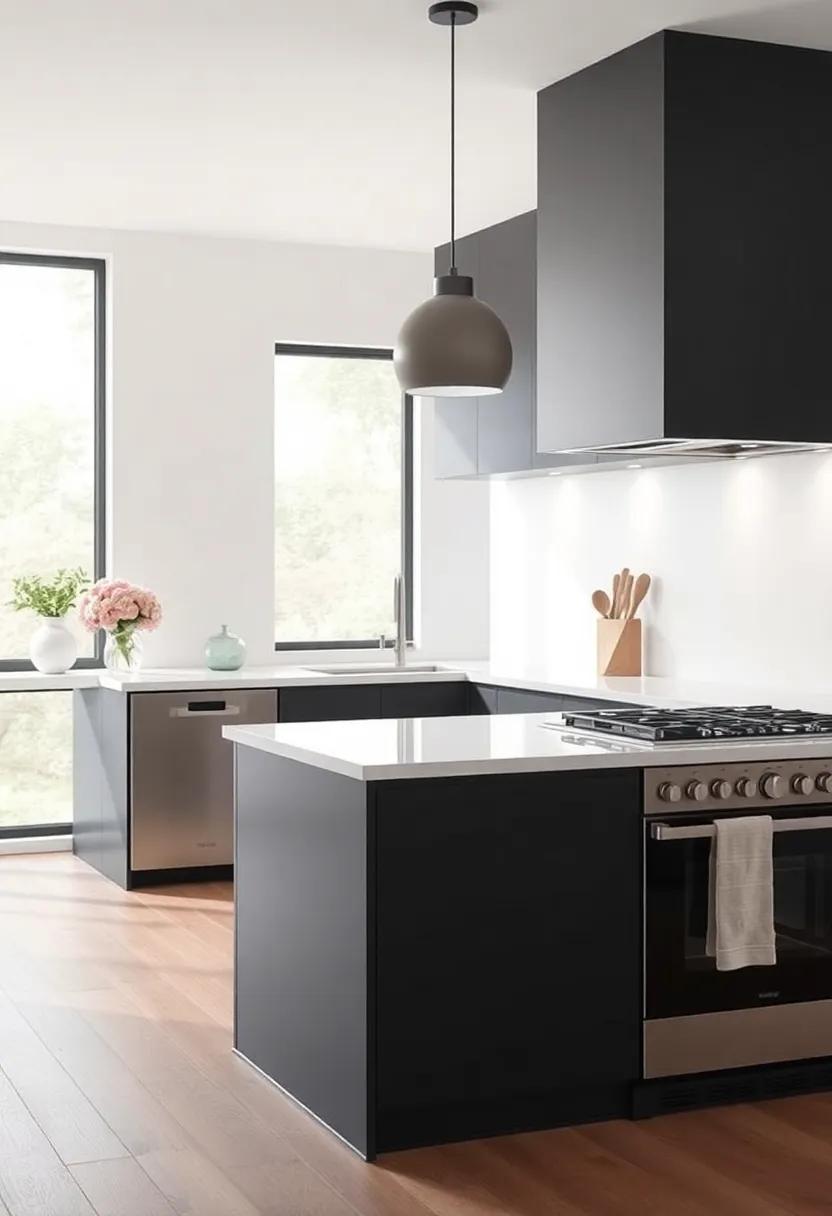
Choosing the right appliances for an open concept space is crucial to achieving a harmonious balance between functionality and aesthetics. Look for appliances that not only fit neatly into the overall design but also resonate with your personal style. Here are some criteria to consider when making your selections:
- Size: Ensure the appliances scale appropriately with the room size to avoid feeling cramped or overwhelming.
- Style: Opt for finishes that complement your decor theme—whether it’s sleek stainless steel, classic white, or bold colors.
- Noise Level: In an open layout, noise can carry easily; consider quieter models for dishwashers and refrigerators.
- Energy Efficiency: Select ENERGY STAR-rated appliances to reduce energy consumption while maintaining high performance.
Once you have narrowed down your choices, it can be helpful to create a visual depiction of how these elements will work together in your space. Use a table to organize your options based on size, price, and energy efficiency:
| Appliance | Size | Price | Energy Rating |
|---|---|---|---|
| Refrigerator | 36″ Width | $2,500 | A++ |
| Dishwasher | 24″ Width | $1,200 | A+ |
| Wall Oven | 30″ Width | $1,800 | A+++ |
Creating Welcoming Entrances to Blend Kitchen and Living Areas
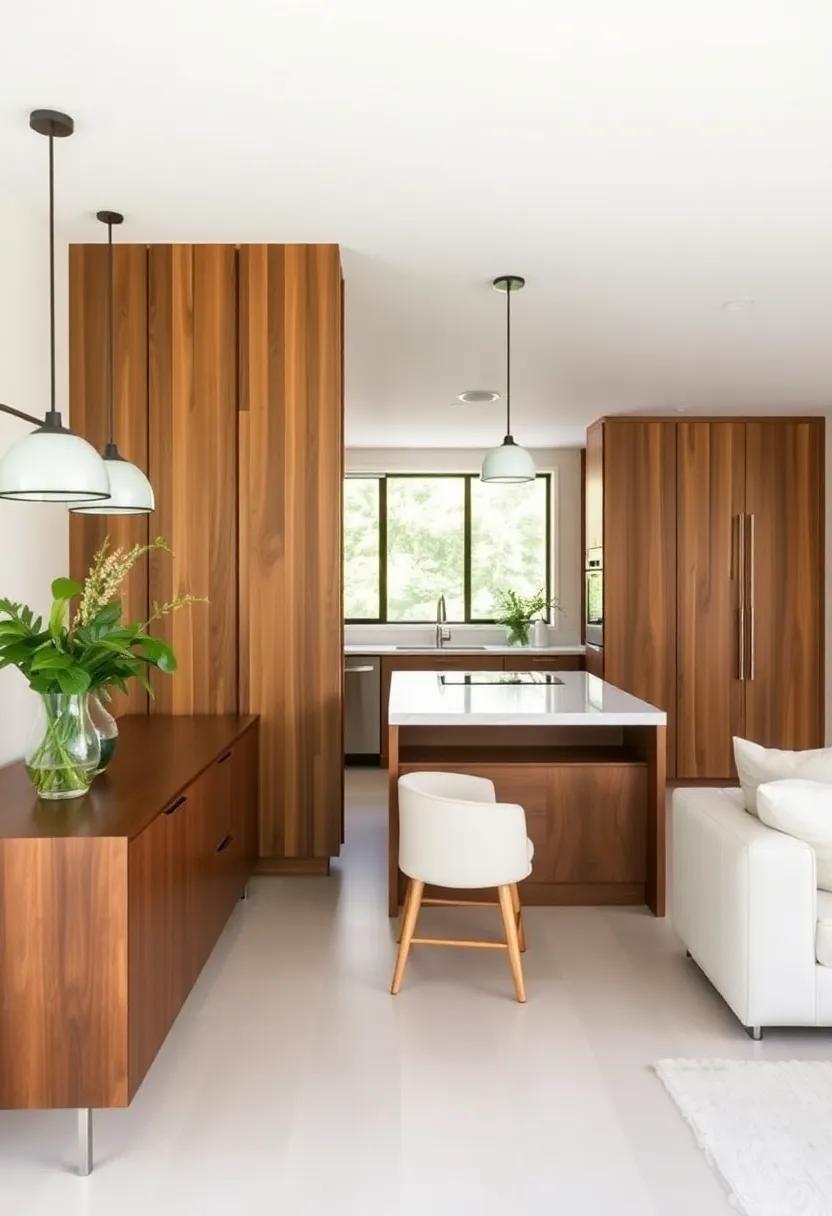
Creating a seamless transition between the kitchen and living areas is essential for fostering a harmonious living environment. To achieve this, consider implementing features that enhance openness and connectivity. Cleverly designed doorways or archways can encourage fluid movement, while large openings eliminate barriers, enhancing the overall feel of the space. For those who prefer a more defined separation, sliding glass doors or bi-fold windows offer a stylish solution that keeps spaces connected yet distinct. Additionally, incorporating a shared color palette across both areas helps to visually unify the two spaces, making them feel like one cohesive unit.
Another way to create a welcoming entrance is through thoughtful furniture placement and accessories. Strive for minimal clutter to maintain a sense of openness,allowing each area to breathe. Consider using area rugs to define spaces further while maintaining a cohesive flow; they can act as visual anchors for seating arrangements. Introduce decorative elements such as artwork or plants to bridge the aesthetic between the kitchen and living area. To simplify your redesign, here’s a quick reference table highlighting key features to consider:
| Feature | Benefit |
|---|---|
| Open Doorways | Enhances flow and accessibility |
| Shared Color Palette | creates a unified look |
| Sliding Glass Doors | Adds natural light and connection |
| Area Rugs | Defines spaces without walls |
Curating Art and Decor That Compliments Your Open Kitchen Design
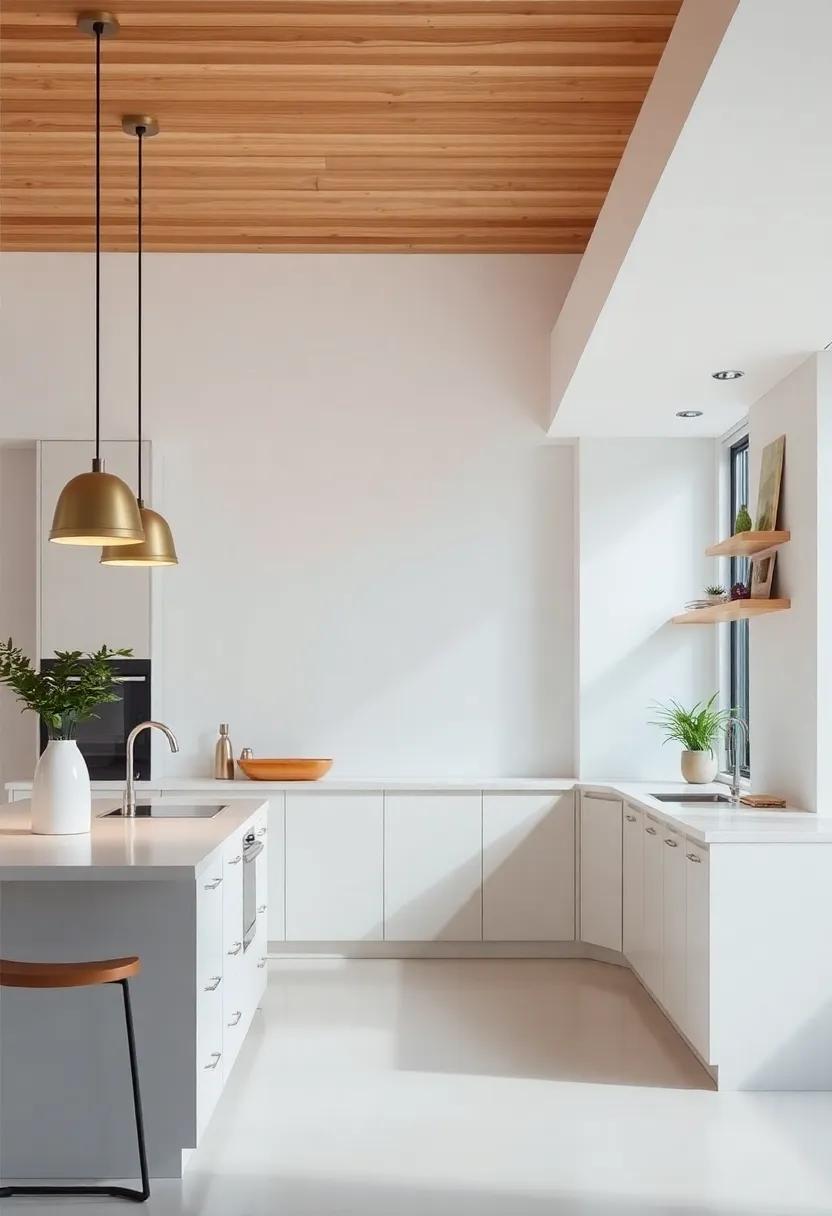
In an open kitchen design, where the boundaries between cooking, dining, and living spaces blur, creating a cohesive visual narrative through art and decor becomes essential.Consider incorporating bold wall art that reflects your personal style and complements the color palette of your kitchen. Vibrant abstract pieces can add a dash of energy, while serene landscapes can introduce a sense of calm. Additionally, the use of decorative shelving can serve both as a functional storage solution and a display area for curated items such as unique ceramics, cookbooks, or potted herbs, allowing you to highlight your personality and maintain an airy feel.
When choosing decorative elements, it’s important to harmonize with your kitchen’s overall aesthetic. A defined theme can bring unity to the space. Consider these ideas for inspiring decor:
- Textured Fabrics: Use table linens, cushions, or curtains in natural materials like linen or cotton to add warmth.
- Statement Lighting: Pendant lights or a stunning chandelier can serve as both illumination and art.
- Greenery: Incorporating potted plants or a small herb garden not only beautifies the space but enhances air quality.
Here’s a simple table for quick reference on decor elements that can elevate your open kitchen:
| Element | Benefit |
|---|---|
| Bold Artwork | Creates a focal point |
| Decorative Shelves | Combines storage with style |
| Accent Lighting | Enhances ambiance |
| Potted Plants | Adds freshness and life |
The Impact of textures in Creating a Cozy Open Concept Atmosphere
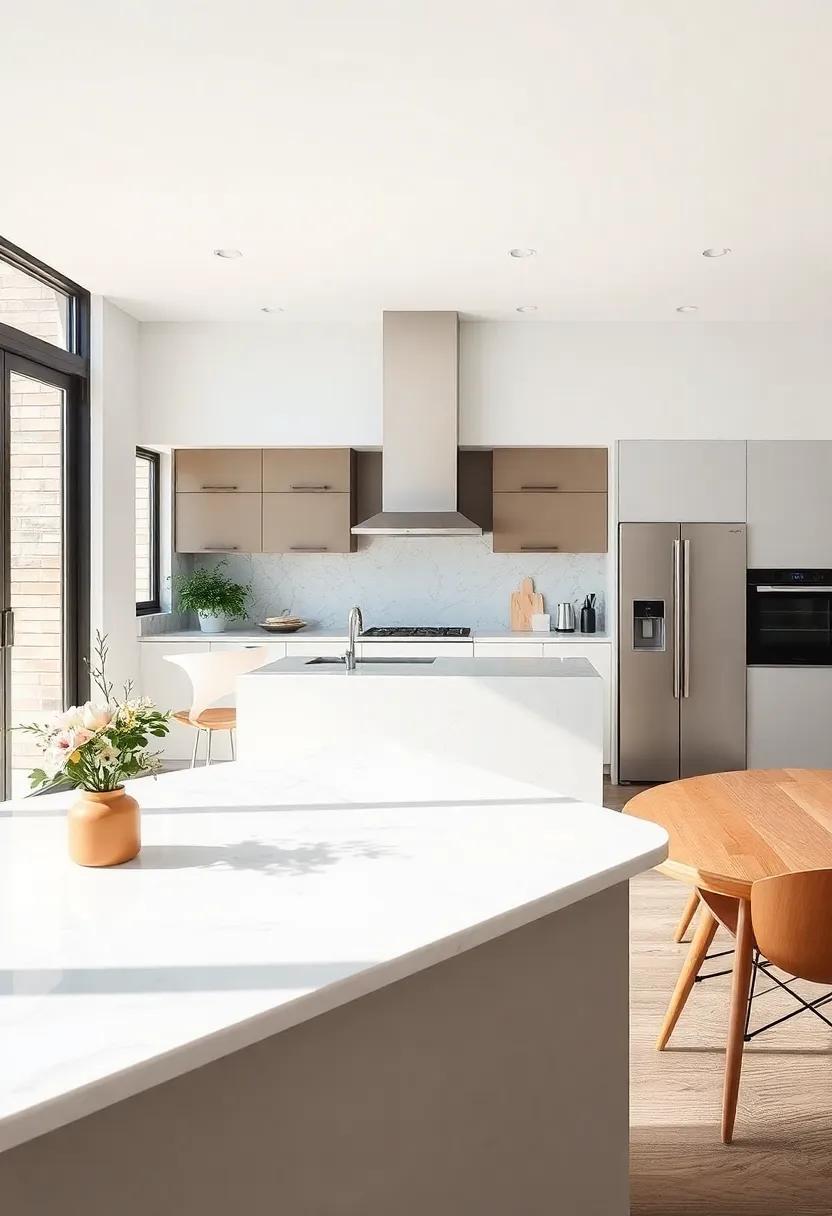
In an open concept layout, creating a warm and inviting atmosphere relies heavily on the careful selection and placement of various textures. Soft fabrics, such as plush throw pillows and cozy blankets, can add depth to the space, making it feel less stark and more welcoming. To enhance the overall comfort, consider incorporating a mix of materials like wood, metal, and glass. Surfaces that combine smooth, rough, shiny, and matte textures can capture light differently, creating a dynamic visual appeal that draws the eye across the room. additionally, layering rugs can add warmth underfoot, helping to define separate areas within the open space.
Focal points such as a textured wall or an artistic backsplash can create visual interest and serve as a conversation starter. Consider these ideas for integrating texture:
- Natural Elements: Raw wood, stone, or plants can introduce an organic feel.
- Textiles: Varying fabric types in seat cushions, curtains, and table linens can add coziness.
- Accent Features: use textured tiles or paneling to create an impactful statement.
- Lighting: Unique lampshades and fixtures can bring in a different texture while adding warmth.
To illustrate the impact of texture on a cozy atmosphere, refer to the following table, showcasing different textural elements that can enhance your open concept kitchen:
| Textural Element | Effect on Atmosphere |
|---|---|
| Wooden Beams | Brings warmth and a rustic charm |
| Textured Backsplash | Adds visual interest and a focal point |
| Woven Textiles | Softens hard surfaces and creates comfort |
| Metal Accents | Coordinates with modern aesthetics and adds sleekness |
establishing a Cohesive Theme for Kitchen and Living Room Harmony
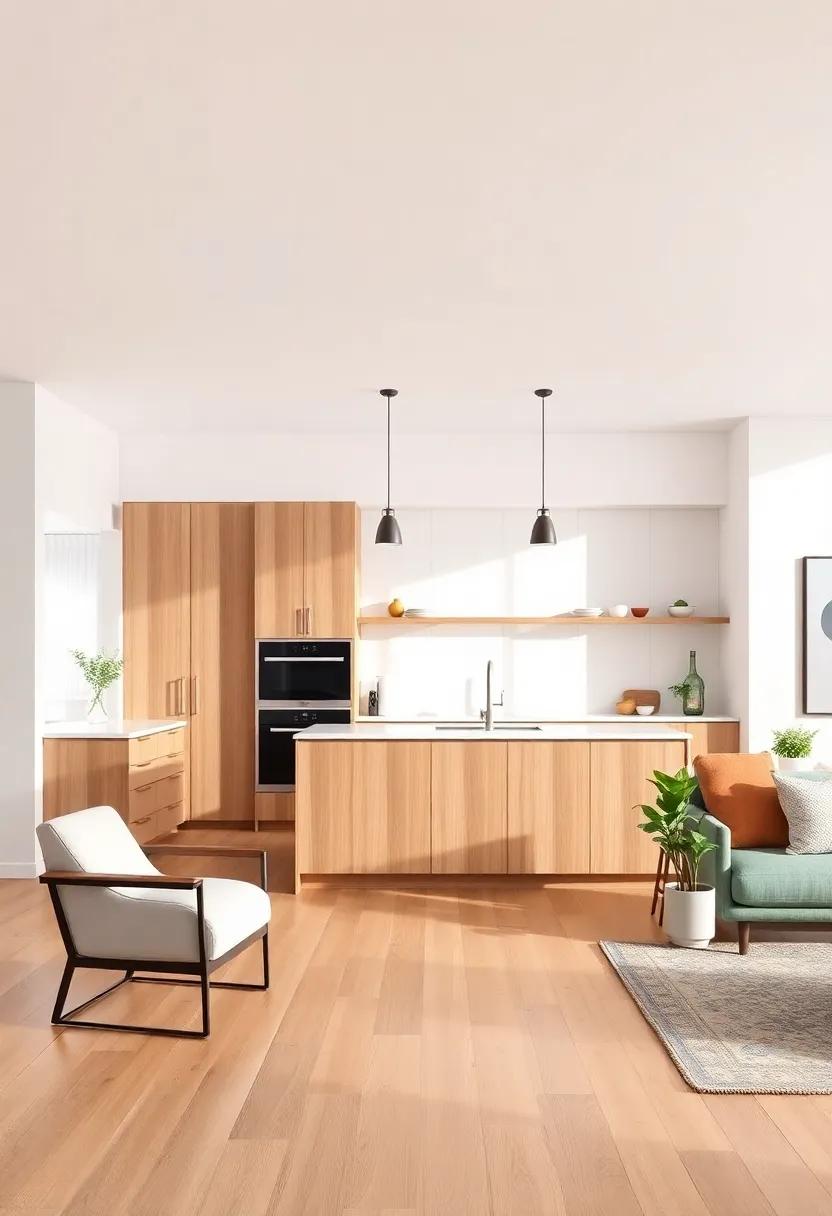
When remodeling your open concept space, consider the importance of a cohesive theme that bridges the kitchen and living room. A well-curated theme not only enhances visual appeal but also contributes to the flow of the space. Begin by selecting a color palette that resonates with both areas. Neutral tones with accent colors can create a seamless transition, while textures such as wood, stone, or metals can tie different elements together.Incorporate similar decorative items, such as:
- Matching light fixtures
- Complementary artwork
- Consistent cabinetry finishes
Additionally, consider the functionality of each space to ensure they work together in harmony. Open shelving can be a practical yet aesthetically pleasing solution, allowing you to showcase kitchenware and decorative pieces that echo the living room’s style. Utilize furniture pieces to create defined areas without drawing a critically important line between them.Opt for:
- Multi-functional furniture
- Area rugs that demarcate zones
- Consistent design themes in soft furnishings
| Element | Kitchen | Living Room |
|---|---|---|
| Color Scheme | Soft neutrals with pops of color | Complementary accent shades |
| Materials | Wood and metal accents | Textured fabrics |
| Lighting | Pendant lights | Floor and table lamps |
Utilizing Open Shelving to Showcase Beautiful Cookware and Decor
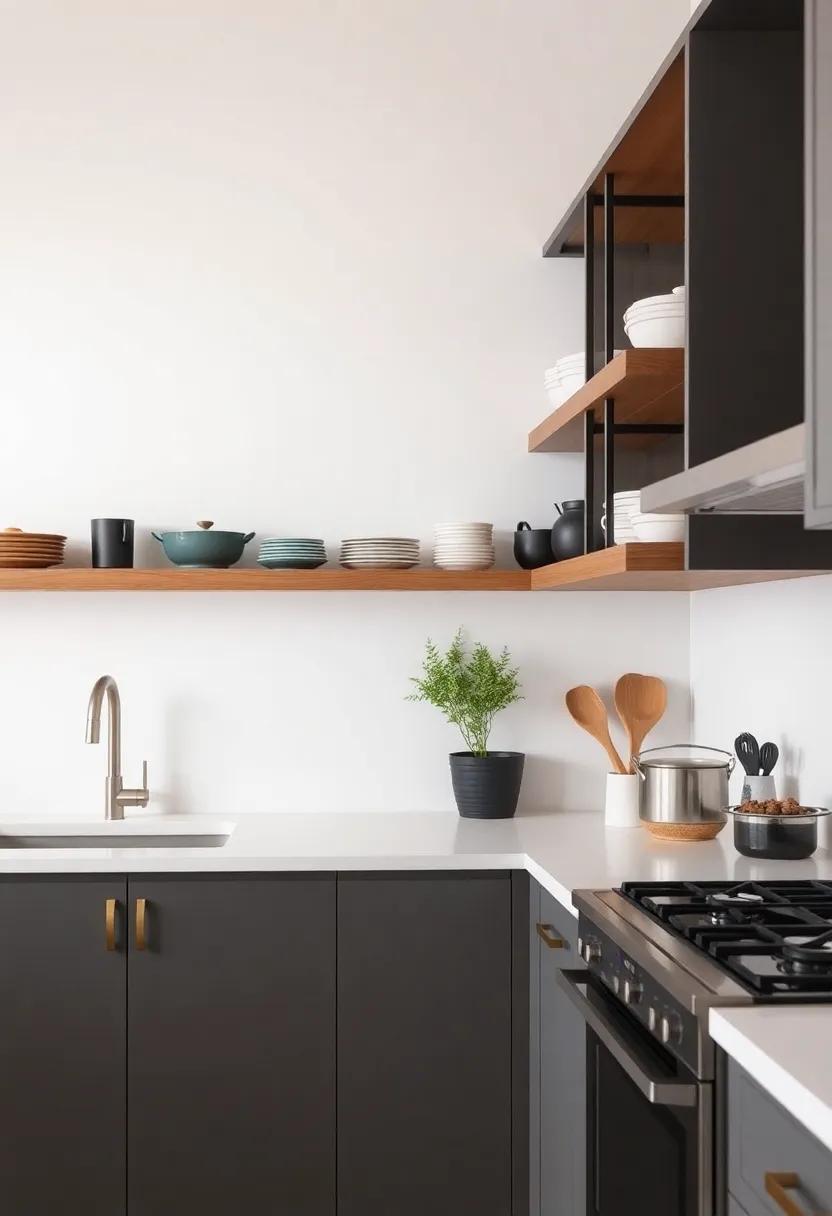
Embracing an open shelving concept not only optimizes your kitchen’s functionality but also transforms it into a curated display of your personal style. Consider using open shelves to elevate your beautiful cookware—from artisan pottery to sleek stainless steel pieces.When arranging items, adopt a balanced yet creative approach. Group similar items by color, size, or style, and incorporate a few decorative accents such as plants or vintage cookbooks. This technique creates a visually appealing focal point that invites admiration while ensuring easy access to your cooking essentials.
To maximize the visual impact of your open shelving, consider the following elements:
- Layering: Position larger items at the back and smaller ones in front to create depth.
- Mixing Materials: Combine wood, metal, and ceramics to add texture and interest.
- Lighting: Incorporate LED strip lights under shelves to enhance the glamour of showcased items.
Additionally, using a
| Cookware Item | visual Impact |
|---|---|
| Ceramic bakeware | Natural warmth |
| Glass Jars | Transparency and freshness |
| Colored Pots | Bold statement pieces |
can swiftly elevate the aesthetic of your kitchen. By thoughtfully curating your open shelves, you not only showcase your culinary passion but also bring a sense of personality and charm to your space.
The Role of Flooring Choices in Unifying Open Concept Spaces
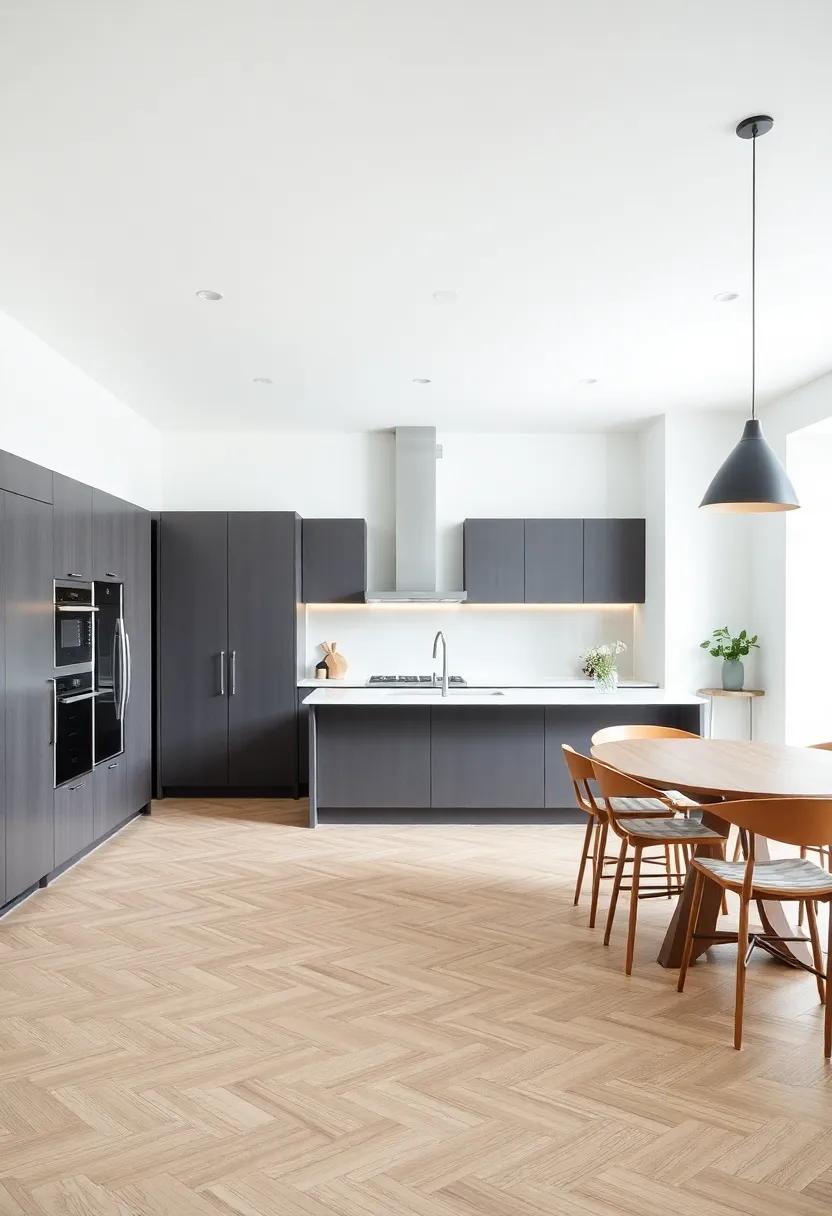
When reimagining an open concept space, the flooring choice serves as a foundational element that harmonizes the visual flow between various areas. From the kitchen to the living room, selecting the right flooring material can create a seamless transition that ties together distinct zones. Popular options include:
- Hardwood: Add warmth and elegance while providing a classic unity.
- Laminates: Offer versatility in design and budget-amiable solutions.
- Tile: Perfect for high-traffic areas while resisting moisture,making it ideal for kitchen usage.
A well-thought-out flooring layout can delineate spaces while maintaining an overall cohesive atmosphere. Implementing a consistent color palette or texture can enhance the sense of continuity, making the transition from one area to another feel intentional and stylish. Consider utilizing a two-tone approach for areas like the kitchen and dining room to visually distinguish them while still harmonizing with surrounding spaces. Below is a comparison of popular flooring options to visualize their potential impact:
| Flooring Type | Texture | Durability | Maintenance |
|---|---|---|---|
| Hardwood | Warm and inviting | Medium | Regular polishing required |
| Laminates | Varied styles | High | Simple cleaning |
| Tile | Cool and sleek | Very high | Easy to clean |
How to Create Distinct Zones Within an Open Kitchen Design
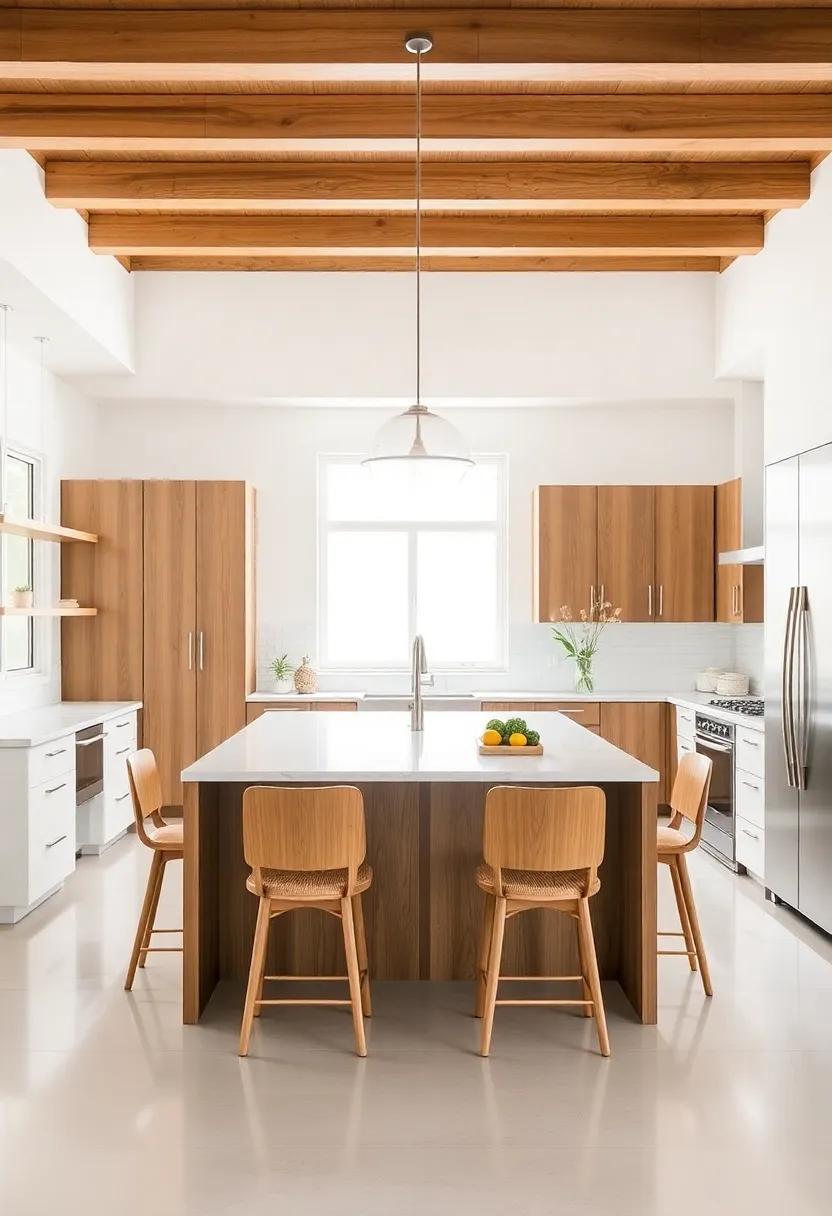
Creating distinct zones in an open kitchen design not only enhances functionality but also elevates the aesthetic appeal of your space. start by identifying key activities—cooking, dining, and entertaining—and allocate specific areas for each. Use islands or peninsulas as natural dividers to demarcate these zones while keeping visual openness. Consider incorporating materials that contrast or complement each area, such as a sleek marble countertop for the cooking zone and rustic wood for the dining area. Additional elements like area rugs, lighting fixtures, and furniture arrangements can also serve to clearly define these zones while adding character and warmth to your kitchen.
When planning your layout, remember to consider the flow between each zone. Open shelving can help maintain visibility while allowing for easy access to items in the cooking zone, whereas closed cabinetry can create a more streamlined look in the dining area. You might include a bar stool seating arrangement on one side of the island for casual dining, while designating a separate table with stylish chairs for more formal meals. To visualize your plan effectively, refer to the table below that highlights design elements to incorporate in each kitchen zone:
| Zone | Design Elements |
|---|---|
| Cooking | Marble Island, Open Shelving, Recessed Lighting |
| Dining | Rustic Wood Table, Pendant Lights, Decorative Centerpiece |
| Entertaining | Bar Stools, Beverage Fridge, Accent Lighting |
Incorporating Greenery for a Fresh Feel in Your Outdoor-connected Kitchen
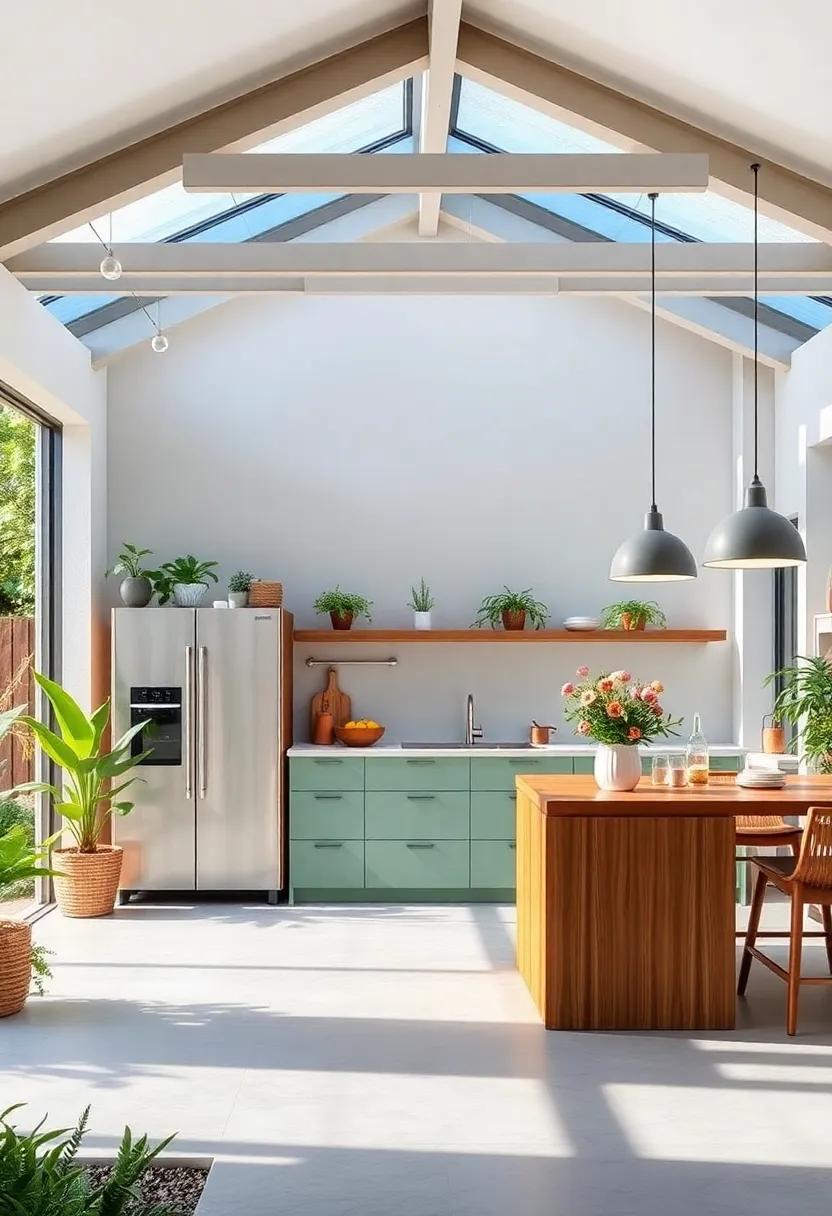
One of the most effective ways to breathe new life into your outdoor-connected kitchen is by introducing an array of greenery that not only enhances the aesthetic but also fosters a harmonious environment. Imagine leafy plants cascading from wall-mounted planters or vibrant herbs flourishing in pots on your kitchen island. Incorporate seasonal flowers, fragrant herbs, and even small trees to create layers of texture and color, drawing the eye both from inside to out and vice versa. Combine elements like:
- Vertical Gardens: Perfect for walls, they utilize space efficiently and provide a stunning backdrop.
- Edible Plants: Fresh herbs like basil or mint can be both decorative and practical for cooking.
- Succulents: Low-maintenance and diverse, these can thrive in sunny spots while adding a modern touch.
To complement these natural elements, consider the furniture and fixtures within the space. Choosing natural materials such as wood or stone can seamlessly blend indoor and outdoor elements together. A wooden trellis adorned with climbing plants can frame your cooking zone, while an outdoor dining area surrounded by lush foliage invites al fresco dining experiences.The following table highlights key plants to consider for your kitchen that not only purify the air but also add charm:
| Plant | Benefits | Care Level |
|---|---|---|
| Parlor Palm | Air purifier | Low |
| Mint | Great for cooking | Moderate |
| Spider Plant | Odor eliminator | Easy |
| Lavender | Calming scent | Low |
Transformative Trends in Open Concept Kitchen Designs for 2024
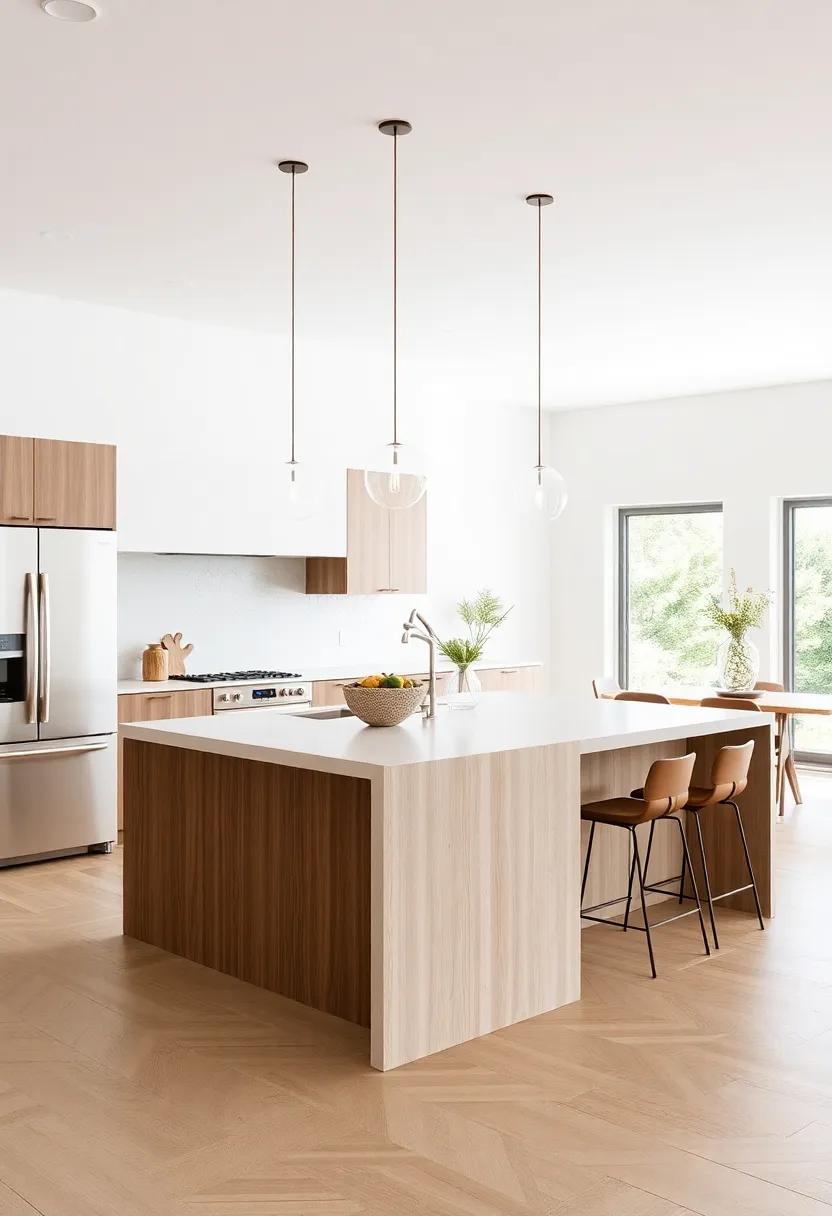
As we look towards 2024, open concept kitchen designs are evolving with a focus on sustainability and smart functionality. Homeowners are increasingly interested in integrating eco-friendly materials and energy-efficient appliances that not only beautify the space but also minimize the environmental impact. Biophilic design is making waves,blending indoor and outdoor elements through the use of large windows,natural materials,and indoor plants. This trend creates a refreshing atmosphere that encourages a connection with nature, turning the kitchen into a vibrant hub of both style and nourishment.
Additionally, multifunctionality takes center stage in 2024’s open concept kitchens.The rise of convertible furniture is transforming how we utilize space, allowing homeowners to adjust their layout based on their needs, whether for entertaining or daily use.key features to consider include:
- Mobile islands that can be reconfigured or tucked away.
- Built-in storage solutions that help minimize clutter.
- Integrated technology to streamline cooking and hosting experiences.
| Trend | Description |
|---|---|
| Eco-Friendly Materials | Sustainable wood, recycled metals, and low-VOC finishes. |
| Biophilic Design | Incorporation of natural light and greenery. |
| Convertible Furniture | Flexible design elements that adapt to usage. |
Concluding remarks
As we draw the curtains on our exploration of open concept kitchen remodels, it’s clear that transforming your space goes beyond mere aesthetics; it’s about crafting an environment that fosters connection and creativity. Whether you’re a culinary enthusiast eager to showcase your skills or a busy household looking to enhance togetherness, the open concept design offers endless possibilities.
Embrace the inspiration gathered from this guide and envision how your kitchen can become the heart of your home,where flavors mingle with laughter and memories are made. Remember, remodeling is not just about changing walls; it’s about reshaping the way you live and interact with those around you.
So, take a deep breath, gather your ideas, and embark on this exciting journey of transformation. Your dream kitchen awaits, ready to reflect your unique style and enhance your daily life. Happy remodeling!
As an Amazon Associate I earn from qualifying purchases.
 theFASHIONtamer Where Style Meets Space, Effortlessly
theFASHIONtamer Where Style Meets Space, Effortlessly 